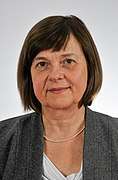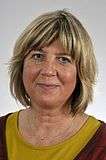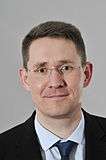2019 Brandenburg state election
The 2019 Brandenburg state election was held on 1 September 2019 to elect the members of the 7th Landtag of Brandenburg.[1][2] It took place on the same day as the 2019 Saxony state election. The incumbent government of the Social Democratic Party (SPD) and The Left, led by Minister-President Dietmar Woidke, was defeated. Both parties suffered significant losses, as did the Christian Democratic Union (CDU). Alternative for Germany (AfD) doubled its number of seats and moved into second place. The Greens also made gains, as did the Free Voters.
| |||||||||||||||||||||||||||||||||||||||||||||||||||||||||||||||||||||||||||||
All 88 seats of the Landtag of Brandenburg 45 seats needed for a majority | |||||||||||||||||||||||||||||||||||||||||||||||||||||||||||||||||||||||||||||
|---|---|---|---|---|---|---|---|---|---|---|---|---|---|---|---|---|---|---|---|---|---|---|---|---|---|---|---|---|---|---|---|---|---|---|---|---|---|---|---|---|---|---|---|---|---|---|---|---|---|---|---|---|---|---|---|---|---|---|---|---|---|---|---|---|---|---|---|---|---|---|---|---|---|---|---|---|---|
| Turnout | 1,265,106 (61.3%) | ||||||||||||||||||||||||||||||||||||||||||||||||||||||||||||||||||||||||||||
| |||||||||||||||||||||||||||||||||||||||||||||||||||||||||||||||||||||||||||||
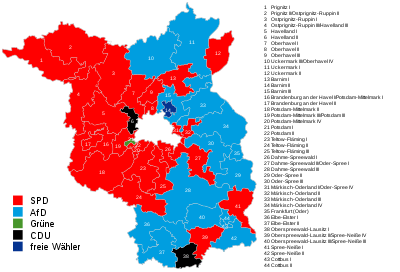 Winning candidates in direct mandates | |||||||||||||||||||||||||||||||||||||||||||||||||||||||||||||||||||||||||||||
| |||||||||||||||||||||||||||||||||||||||||||||||||||||||||||||||||||||||||||||
After the election, the SPD formed a government with the CDU and Greens. Woidke was subsequently re-elected as Minister-President.
Background
Since German reunification, the SPD has been the strongest party in Brandenburg on a state level, and has held the office of Minister-President continuously.
The SPD and Left formed a coalition government after the 2009 state election, which was renewed after the 2014 state election. In the 2019 European Parliament election in Germany, AfD was the strongest party in Brandenburg on 19.9%, ahead of the CDU (18.0%) and SPD (17.2%).
Electoral system
In principle, the Landtag consists of 88 members. 44 are elected by plurality vote in single-member constituencies (direct mandates), and the remainder are filled by party-list proportional representation. The seats are distributed according to the largest remainder method (Hare-Niemeyer method). Only parties whose share of second votes exceeds the 5% electoral threshold or which have won a direct mandate (the "basic mandate clause") are allocated seats.[3] Overhang and leveling seats can expand the Landtag to a maximum size of 110 seats. This is detailed in the Brandenburg State Electoral Act.[4]
According to the state constitution and the state election law, the election date must be a Sunday or a public holiday, at the earliest 57 months and at the latest 60 months after the beginning of the election period. In 2019, the date was set for 1 September 2019.[3]
The minimum voting age is 16 years.
Parties
The table below lists parties represented in the 6th Landtag of Brandenburg.
| Name | Ideology | Leader(s) | 2014 result | |||
|---|---|---|---|---|---|---|
| Votes (%) | Seats | |||||
| SPD | Social Democratic Party of Germany Sozialdemokratische Partei Deutschlands |
Social democracy | Dietmar Woidke | 31.9% | 30 / 88 | |
| CDU | Christian Democratic Union of Germany Christlich Demokratische Union Deutschlands |
Christian democracy | Ingo Senftleben | 23.0% | 20 / 88 | |
| Linke | The Left Die Linke |
Democratic socialism | Kathrin Dannenberg | 18.6% | 17 / 88 | |
| AfD | Alternative for Germany Alternative für Deutschland |
National conservatism | Andreas Kalbitz | 12.2% | 11 / 88 | |
| Grüne | Alliance 90/The Greens Bündnis 90/Die Grünen |
Green politics | Ursula Nonnemacher | 6.2% | 6 / 88 | |
| BVB/FW | Brandenburg United Civic Movements/Free Voters Brandenburger Vereinigten Bürgerbewegungen/Freie Wähler |
Regionalism | Péter Vida | 2.7% | 3 / 88 | |
Opinion polls
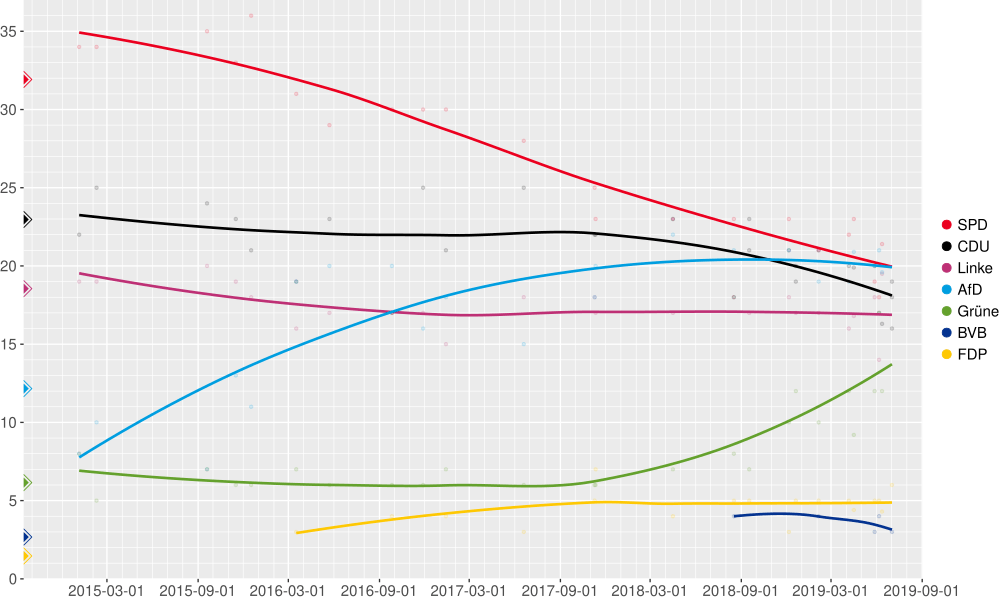
| Polling firm | Fieldwork date | Sample size |
SPD | CDU | Linke | AfD | Grüne | FDP | BVB/FW | Others | Lead |
|---|---|---|---|---|---|---|---|---|---|---|---|
| 2019 state election | 1 Sep 2019 | – | 26.2 | 15.6 | 10.7 | 23.5 | 10.8 | 4.1 | 5.0 | 4.1 | 2.7 |
| Forschungsgruppe Wahlen | 26–29 Aug 2019 | 1,653 | 22 | 16.5 | 14 | 21 | 14.5 | 5 | 4 | 3 | 1 |
| Civey | 31 Jul–28 Aug 2019 | 2,460 | 20.3 | 17.9 | 15.5 | 20.3 | 14.8 | 4.9 | – | 6.3 | Tie |
| INSA | 19–26 Aug 2019 | 1,019 | 21 | 17 | 15 | 21 | 14 | 5 | 5 | 2 | Tie |
| Forschungsgruppe Wahlen | 19–22 Aug 2019 | 1,112 | 21 | 18 | 14 | 20 | 14 | 5 | 4 | 4 | 1 |
| Infratest dimap | 19–21 Aug 2019 | 1,002 | 22 | 18 | 15 | 22 | 12 | 5 | 4 | 2 | Tie |
| Civey | 16 Jul–13 Aug 2019 | 2,981 | 18.2 | 17.1 | 14.7 | 21.0 | 17.2 | 5.5 | – | 6.3 | 3.2 |
| Forsa | 25 Jul–5 Aug 2019 | 1,009 | 17 | 18 | 14 | 21 | 16 | 5 | 4 | 5 | 3 |
| Civey | 19 Jun–17 Jul 2019 | 2,895 | 17.2 | 16.3 | 16.9 | 21.3 | 15.1 | 5.2 | – | 8.0 | 4.1 |
| INSA | 24 Jun–1 Jul 2019 | 1,001 | 19 | 18 | 16 | 19 | 16 | 6 | 3 | 3 | Tie |
| Civey | 15 May–12 Jun 2019 | 3,007 | 21.4 | 16.3 | 19.5 | 19.6 | 12.0 | 4.3 | – | 6.9 | 1.8 |
| Infratest dimap | 3–6 Jun 2019 | 1,000 | 18 | 17 | 14 | 21 | 17 | 5 | 4 | 4 | 3 |
| INSA | 13–28 May 2019 | 1,011 | 19 | 20 | 18 | 20 | 12 | 5 | 3 | 3 | Tie |
| 2019 European election | 26 May 2019 | – | 17.2 | 18.0 | 12.3 | 19.9 | 12.3 | 4.4 | 2.2[lower-alpha 1] | 13.7 | 1.9 |
| Civey | 19 Mar–16 Apr 2019 | 1,380 | 23.0 | 19.9 | 16.8 | 20.9 | 9.2 | 4.4 | – | 5.8 | 2.1 |
| Infratest dimap | 2–6 Apr 2019 | 1,000 | 22 | 20 | 16 | 19 | 12 | 5 | – | 6 | 2 |
| Civey | End Jan–22 Feb 2019 | 5,955 | 21.8 | 22.1 | 20.0 | 18.8 | 7.0 | 4.4 | – | 5.9 | 0.3 |
| INSA | 28 Jan–4 Feb 2019 | 1,006 | 21 | 21 | 17 | 19 | 10 | 5 | 4 | 3 | Tie |
| Forsa | 17–20 Dec 2018 | 1,005 | 20 | 19 | 17 | 20 | 12 | 5 | – | 7 | Tie |
| pmg | 19 Nov–6 Dec 2018 | 1,006 | 23 | 21 | 18 | 21 | 10 | 3 | – | 4 | 2 |
| Infratest dimap | 12–17 Sep 2018 | 1,000 | 23 | 21 | 17 | 23 | 7 | 5 | – | 4 | Tie |
| INSA | 10–17 Aug 2018 | 1,048 | 23 | 18 | 18 | 21 | 8 | 5 | 4 | 3 | 2 |
| Infratest dimap | 11–16 Apr 2018 | 1,000 | 23 | 23 | 17 | 22 | 7 | 4 | – | 4 | Tie |
| Infratest dimap | 7–11 Nov 2017 | 1,005 | 23 | 22 | 17 | 20 | 6 | 7 | – | 5 | 1 |
| Forsa | 7–9 Nov 2017 | 1,002 | 25 | 22 | 18 | 18 | 6 | 5 | – | 6 | 3 |
| 2017 federal election | 24 Sep 2017 | – | 17.6 | 26.7 | 17.2 | 20.2 | 5.0 | 7.1 | 1.2[lower-alpha 1] | 5.1 | 6.5 |
| Infratest dimap | 15–19 Jun 2017 | 1,000 | 28 | 25 | 18 | 15 | 6 | 3 | – | 5 | 3 |
| Forsa | 9–13 Jan 2017 | 1,003 | 30 | 21 | 15 | 18 | 7 | 4 | – | 5 | 9 |
| Infratest dimap | 24–28 Nov 2016 | 1,000 | 30 | 25 | 17 | 16 | 6 | – | – | 6 | 5 |
| Forsa | 20–26 Sep 2016 | 1,001 | 30 | 17 | 17 | 20 | 6 | 4 | – | 6 | 10 |
| Infratest dimap | 19–23 May 2016 | 1,002 | 29 | 23 | 17 | 20 | 6 | – | – | 5 | 6 |
| Forsa | 14–17 Mar 2016 | 1,003 | 31 | 19 | 16 | 19 | 7 | 3 | – | 5 | 12 |
| Forsa | 9–17 Dec 2015 | 1,002 | 36 | 21 | 18 | 11 | 6 | – | – | 8 | 15 |
| Infratest dimap | 12–16 Nov 2015 | 1,000 | 33 | 23 | 19 | 13 | 6 | – | – | 6 | 10 |
| Forsa | Sep 2015 | 1,002 | 35 | 24 | 20 | 7 | 7 | – | – | 7 | 11 |
| Infratest dimap | 5–8 Feb 2015 | 1,000 | 34 | 25 | 19 | 10 | 5 | – | – | 7 | 9 |
| Forsa | Dec 2014 | 1,001 | 34 | 22 | 19 | 8 | 8 | – | – | 9 | 12 |
| 2014 state election | 14 Sep 2014 | – | 31.9 | 23.0 | 18.6 | 12.2 | 6.2 | 1.5 | 2.7 | 5.5 | 8.9 |
Results
By early afternoon, significantly more people had voted than at the same time in the 2014 election. According to the state election director, 31.3% of voters cast their ballots by 2:00 PM. At the time in 2014, the figure was only 22.4%.[5]
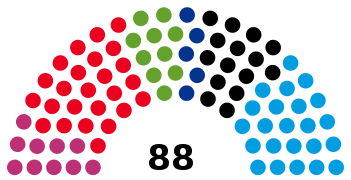 | ||||||||
| Party | Votes | % | +/- | Seats | +/- | Seats % | ||
|---|---|---|---|---|---|---|---|---|
| Social Democratic Party (SPD) | 331,238 | 26.2 | 25 | 28.4 | ||||
| Alternative for Germany (AfD) | 297,484 | 23.5 | 23 | 26.1 | ||||
| Christian Democratic Union (CDU) | 196,988 | 15.6 | 15 | 26.1 | ||||
| Alliance 90/The Greens (Grüne) | 136,364 | 10.8 | 10 | 11.4 | ||||
| The Left (Linke) | 135,558 | 10.7 | 10 | 11.4 | ||||
| Brandenburg United Civic Movements/Free Voters (BVB/FW) | 63,851 | 5.0 | 5 | 5.7 | ||||
| Free Democratic Party (FDP) | 51,660 | 4.1 | 0 | ±0 | 0 | |||
| Human Environment Animal Protection | 32,959 | 2.6 | 0 | ±0 | 0 | |||
| Pirate Party Germany (Piraten) | 8,712 | 0.7 | 0 | ±0 | 0 | |||
| Others | 10,292 | 0.8 | 0 | ±0 | 0 | |||
| Total | 1,265,106 | 100.0 | 88 | ±0 | ||||
| Voter turnout | 61.3 | |||||||
Government formation
The governing SPD and Die Linke both suffered losses, bringing an end to their coalition. Incumbent Minister-President Woidke (SPD) invited all parties except AfD to coalition negotiations as his party remained the largest bloc. The CDU expressed interest in joining a so-called "Kenya coalition" with SPD and Greens, which would have 50 seats, and reiterated their refusal to govern with AfD. Woidke confirmed he called CDU leader Senftleben on election day to begin discussions, but expressed reservations about the party's poor performance under pressure from the right. He also did not rule out the possibility of a red-red-green coalition with Die Linke and Greens, which would have a bare majority of 45 seats.[6] Greens leader Nonnemacher expressed willingness to participate in either coalition, but made it clear her party would bring its own policy goals to the table and refuse to merely prop up the existing red-red coalition.[7]
On November 16th, both the CDU and SPD voted in favor of a "Kenya coalition."[8] The Greens approved the coalition on the 18th; Woidke was duly voted in for his second term as Minister-President two days later by a count of 47 to 37 with 3 abstentions. The coalition commands 50 seats.[9][10]
Notes
References
- "Die nächsten Wahlen in Deutschland:". wahlrecht.de. 2018-09-14.
- "Landtagswahlen | Wahlen Brandenburg". wahlen.brandenburg.de. Retrieved 2019-05-05.
- "BRAVORS - Schnellsuche".
- Brandenburgisches Landeswahlgesetz Fassung: 28. Januar 2004, Änderung: 11. Februar 2014
- "Landtagswahl in Brandenburg: Wahlbeteiligung ist bisher deutlich höher als 2014". rbb24.de. Retrieved 1 September 2019.
- "In Brandenburg ist eine Koalition aus SPD, CDU und Grünen wahrscheinlich". www.tagesspiegel.de (in German).
- "Grüne nennen ihren Preis für Koalitionen". n-tv.de (in German).
- "Kenia in Brandenburg: CDU stimmt klar für Koalition mit Rot-Grün". www.rnd.de (in German). Retrieved 2019-11-18.
- "Brandenburg: Grüne stimmen für Kenia-Koalition: Landtagswahl Brandenburg 2019: Endgültiges Ergebnis". Spiegel Online. 18 November 2019.
- "Brandenburg: Dietmar Woidke als Ministerpräsident wiedergewählt: Landtagswahl Brandenburg 2019: Endgültiges Ergebnis". Spiegel Online. 20 November 2019.
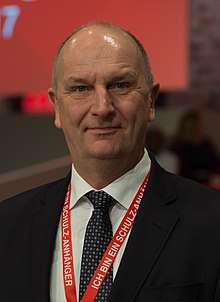
.jpg)
.jpg)
